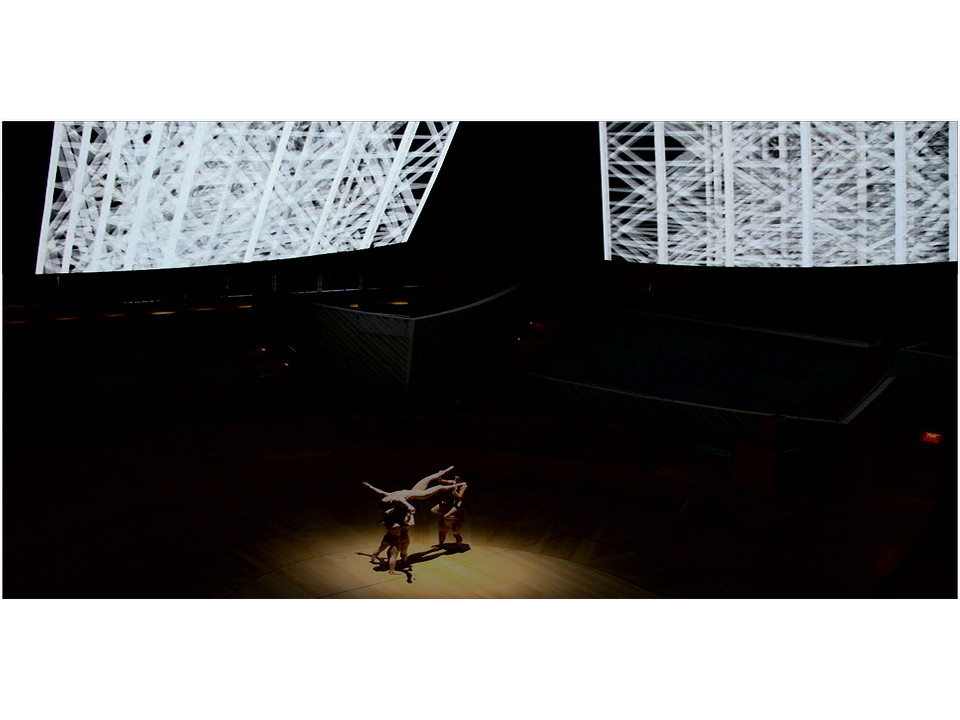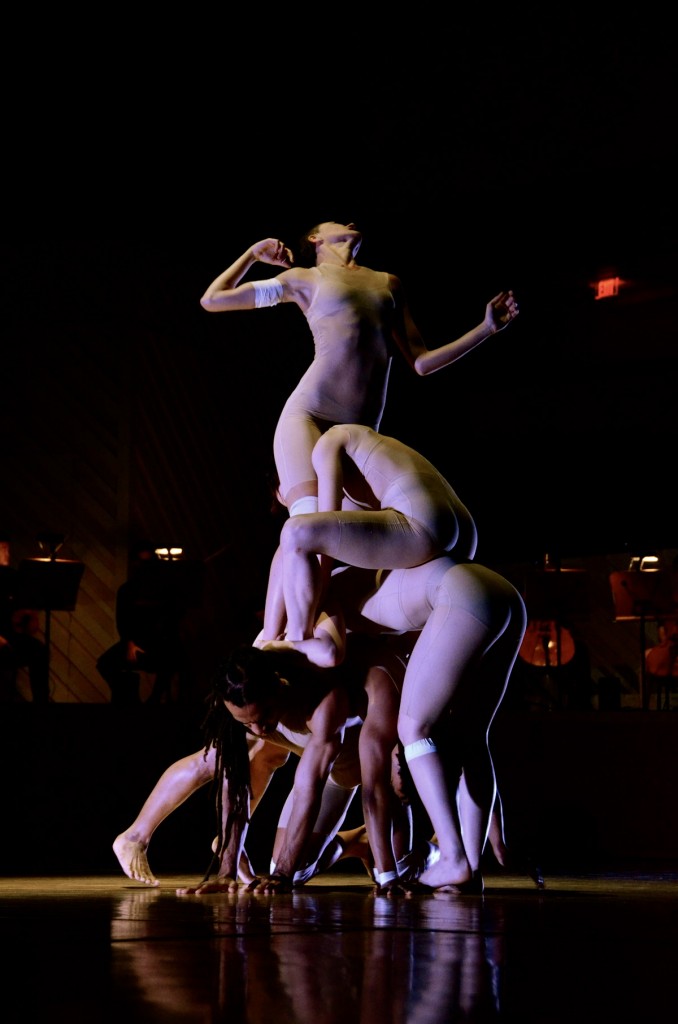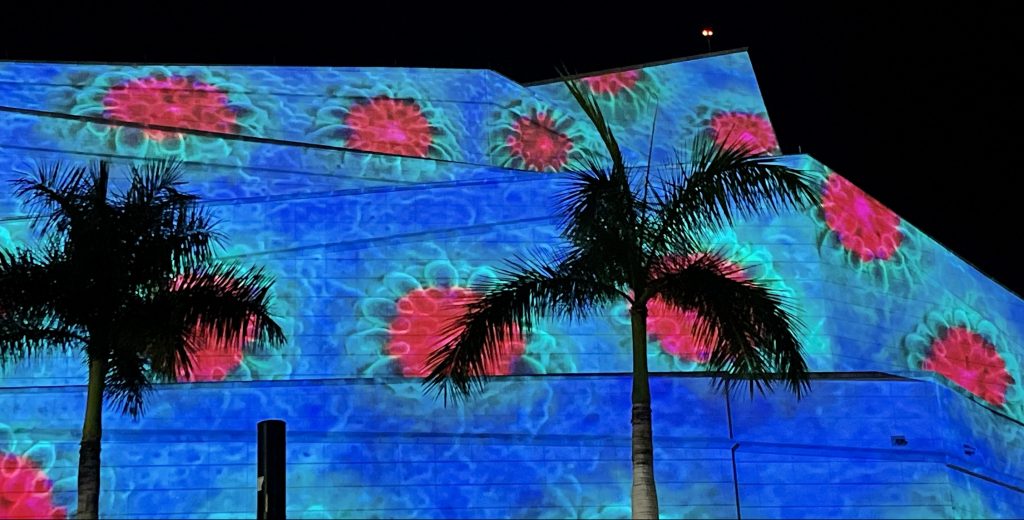
Yara Travieso’s “SET” list
I interviewed director, choreographer and co-founder of the Borscht Film Festival (a Knight Arts grantee) Yara Travieso last May when “SET,” her latest work, premiered during the Metamoto Musician + Choreographer Forum at the New World Symphony. Travieso’s work is sonic, visceral and rich. It is also unexpected. In this interview, Travieso discusses the creative energy that powers her work and gives us insight into the passion and obsessions that make a true artist. Neil de la Flor: Tell us about “SET.” Why did you create this work? Yara Travieso: “SET” is a new work that premiered at The New World Center on May 11-15, 2011 as part of the Metamoto Musician + Choreographer Forum. The piece involved a number of collaborators that included composer Jerome Begin and a septet of New World Symphony Fellows, architectural designer and artist Chat Travieso, fashion designer Fabiola Arias, director of photography Darren Hoffman, illustrator Ryan Hartley and five professional dancers. The piece was the first multidisciplinary work of its scale in the new space and premiered at the tail end of the New World Symphony’s 2011 season. In the piece, seven string instruments are amplified and electronically processed, manipulated live by Begin. In conjunction, five dancers create tense cinematic episodes, both live and projected, on the various video screens floating above the stage.
In “SET,” I wanted to create a world full of uncertainty, distortion and disorientation, both sonically and visually, for the performers on stage and the viewers; zooming into how terrifying this could be, or exciting, or liberating. The work strives to create a kind of foreignness found in a place, circumstance or inside one’s own body. “SET” will make its premiere in other cities in the upcoming year.
ND: How was “SET” conceived? Where did the idea originate?YT: “SET” was conceived from a collection of strange experiences in the past few years of my life; the heaviness that comes with the real world outside of school, the oddness of two cities that became my lover and my mistress, the death of very close family members, no money, then some money, break ups, amazing opportunities, strange adventures, meeting some of the most inspiring people I’ve ever experienced and building a somewhat sturdy ladder on which to climb. In general, I think these are very bizarre times to live in and coming to terms with just how strange and uncertain this moment, right now, is was something with which I became obsessed. I have very visual dreams that, in the past, have kept me from sleeping for days. Prior to creating “SET,” I had a strange dream: Everything is in my point of view. I’m looking up and the only things I see are two skyscrapers on either side of me. I seem to be falling backward. I feel weightless, as though I’ve reached terminal velocity and all I really understand from these structures are blurry horizontal lines in repetition, (the building’s facade). These lines form a foggy but comforting visual rhythm and become the soundtrack to the episode. I found myself both excited and terrified for the point of contact with the ground — not because of the connotations of death, but because there was no way of knowing when it was going to happen. This displacement of space and time and play on tension versus compression was the foundation of the anxiety I felt everyday. I wanted to build tension comparable to that found in nightmares or horror thrillers, so I created a series of physical systems and structures that were unpredictable in theory and in action. “SET” is also an exploration of time perception, similar to ’90s action movies (the kind with Sandra Bullock) where a bomb’s countdown is somehow prolonged, creating friction between our expectations and what we actually see. Paralleling this was the thematic play of the space itself. This piece was always thought of as site-specific and Gehry’s new space definitely fuels much inspiration. The biggest thing for me was to not fight the environment, but, instead, ignore “theatre” and embrace architecture in a way that the bodies and video in the space were to quote or warp the design of the center itself. I guess I was trying to come to terms and cope somehow with my own state of constant displacement, my love for cinematic genres and my ties to architecture. Despite all the careful planning, this piece feels more personal than any of my other works. I can see whole sections that tell me about my relationship with my father and another about my mother or grandmother. It was only fitting for me to bring and premiere this piece back to my hometown of Miami.
ND: “SET” is a collaboration with composer Begin, visual artist Hartley and architectural designer Travieso, as well as fashion designer Arias. What are the challenges and rewards of collaboration?
YT: I think that, similar to many generations before ours, we thrive on notions of creating, not only a work, but a voice that can define our time. To create this unique voice, we need volume and the right sonic combination. I like to feel the surge of a new idea with a group of people and the triumph of the creation with all the minds that made it happen. I also sometimes think I collaborate because I can’t stand still in one place . I don’t think or function in one field; instead, I think through images in time, which, for me, always requires an experience built from scratch, with different points of views for very specific, but different, platforms. I like being reminded how little I really know when a conversation uncovers new thoughts for everyone involved. By collaborating, I am also avoiding the dreaded subcultural void that comes with genre-specific work and their audiences, such as in dance, theater, film, opera, installation, etc … There is something wonderful that happens when you have a theater or museum or cinematheque or gallery or storefront full of architects, filmmakers, students, engineers, teachers, designers and doctors all there to have a private experience in public. Because of the particular journey of “SET,” I was interested in assembling a team to which I felt very close and familiar, as well as a group that could relate to my current obsession with “uncertainty.” I am lucky enough to know a group of creators and designers who individually have a very clear and powerful voice in their respective fields. Begin, Travieso, Arias, Hartley and Hoffman are definitely my Wade + LeBron + Bosh dream team. Made up of a Miami + N.Y.C. hybrid, each collaborator brings specific ideas of new music, architecture, fashion, illustration and film to the project. Working with such a close team of colleagues, friends, siblings and individual minds can sometimes be overwhelming; there is never a clear line between life, creation and friendship, which can be difficult to live with all the time. Nevertheless, I have come to realize that it is this intimate process that fuels the guts and blood of the work. In a place where my colleagues know so much about me and their own craft, I realize how little I know about everything else, and this is a scary, yet wonderful, place to begin a piece about uncertainty.
ND: For the performance at the New World Symphony, I read that Begin amplified seven string instruments electronically and processed them live as a way to subvert the formal orchestral experience by creating distortion and disorientation.Why?
YT: The themes of distortion and disorientation needed to be pronounced throughout every aspect of the work in order to make all the experiences in the piece as visceral as possible. I asked Jerome this question and he answered with: ‘The idea of distortion and disorientation came from our early conversations about the work. Inspired by the Gehry space and by visual concepts (such as the sustained fall with no beginning or end), I sought to disarm the audience from the first moment of the piece, putting them in a mental space where they don’t know the rules. They see classical musicians in a concert hall with string instruments, but each time the musicians play, there is no predicting what the sound will be.’
ND: What motivated you to become a dancer, director and choreographer?
YT: Choreography motivated me to dance, film motivated me to choreograph and needing to say things outside of dance motivated me to direct, also Peter Greenaway, Kubrick and Miguel de Unamuno. ND: What inspires you on a daily basis?
YT: Kwaidan (Japanese ghost stories), dreamy agent Dale Cooper from “Twin Peaks,” Archigram and Cedric Price Architecture, scaffoldings, Miami, Miami’s scaffoldings, trying to remember things, humans turning into creatures, body horror films, Shark Week, natural and artificial lights, taking medium temperature showers, unexplored oceanic territory, public spaces, Chat Travieso, pulley systems, the collaborators in my life right now, faces and the way they move, Italo Calvino, Richard Serra, my body changing with age, panic attacks, rhythmic syncopations, Jerome Begin, mood rings, animals eating other animals, fashion, digitally processed sounds, von Trier, Greenaway, Lynch, Hitchcock, Malick, Kubrick, Herzog, Robert Wilson, Cronenberg, my Abuela, mash-ups (especially ones involving The Fugees and Radiohead), my mom and her relentless creative energy, my dad’s advice and his ability to distinguish thoughts from dreams.
ND: Biggest breakthrough?
YT: When I was 5, I thought my biggest breakthrough was being strong enough to stop checking on my time capsule every hour. When I was 9, I thought my biggest breakthrough was locking myself in my room and intentionally moving very awkwardly to music and realizing that “at this moment, there is not one other person in the world that is moving their right arm this fast, while jumping on one leg this slow, while making a face this strange …” and believing that this was, for some reason, very important. When I was 15, I thought it was buying my first video camera with my Quinceañera money (Cannon GL2). In 10 years, I think I will understand what I thought my biggest breakthrough was in 2011, at which point, it hopefully would have changed.
ND: Biggest setback?
YT: Honestly, there are so many things that seem like a setback: funding, time, personal life, weather, unreliable resources or people. My first full-length work had a limited start-up budget, so instead of spending most of it on production expenses, such set space to film in, materials, etc … we just snuck into an institution on a national holiday to film all day and created my favorite set piece to date: a 60-foot piece of spandex that, depending on how it was manipulated, could shape shift into just about anything, including a giant python and a city scape. I really hate to say it, but, these “setbacks” are just another part of the process, which can sometimes make me more frustrated but mainly more creative. I feel like a problem solver most of the time, and creatively, that is what I think we are doing, solving the problems we created. Of course, more funding is always beneficial.
ND: What is the one (or manifold) thing/s you would like your audience to feel or remember when they leave “SET” or any of your performances?
YT: I would like them to feel the way a bonobo does at the sight of a violent waterfall 2:25 minutes into http://www.youtube.com/watch?v=eubDSQrFako or The way Alex from Kubrick’s “A Clockwork Orange” felt about Beethoven’s 9th: http://www.youtube.com/watch?v=cQCQRLA05AA ND: What’s next for you?
YT: In September of 2011 I will collaborate with director of photography Adam Santelli in L.A. on an underwater video piece as part of a bigger video and installation project for various spaces. I am very excited to work with Adam and his very specific and magical brain. As a long-term project for 2012, I am in the beginning stages of adapting and directing a full evening of Lafcadio Hearn’s collection of Japanese ghost stories, Kwaidan. I will continue my collaborations with new music composer, Jerome Begin and architectural designer/artist/brother Chat Travieso. The stories will be adapted as a kind of film + architecture design + live music ghost tales. This will most likely premiere in N.Y., although, Miami is on my agenda. I am currently collaborating with Miami artist Mira Lehr for a series of installation pieces in a Miami/N.Y. gallery show. I’ve always wanted to collaborate with a woman with so much experience, since my relationship with my grandmother was very important. However, Mira is far from a grandmother or mother figure for me . She is a troublemaker and the good kind. She is very inspiring, and I’m excited to see where we take the work. Also in the fall of 2011, I will complete part I of a video trilogy of fashion designer Fabiola Arias’ collections. I’m currently working on getting yaratravieso.com running by winter of 2011.
Recent Content
-
Artsarticle ·
-
Artsarticle ·
-
Artsarticle ·



